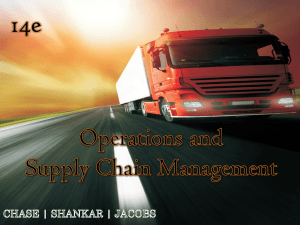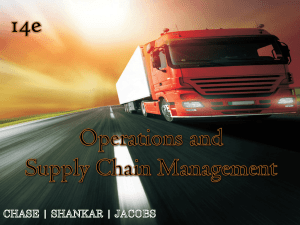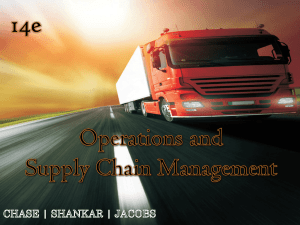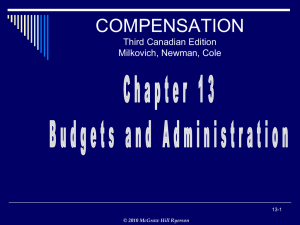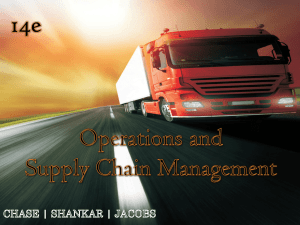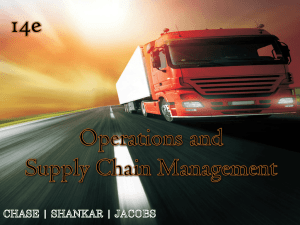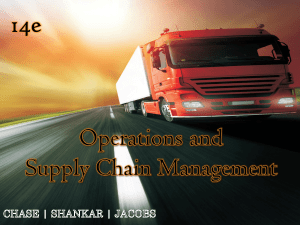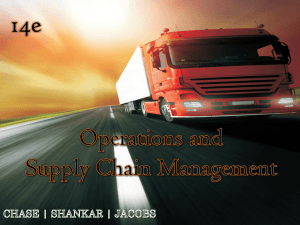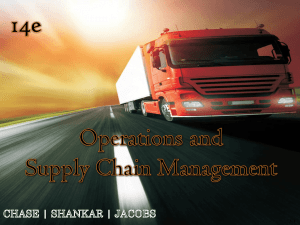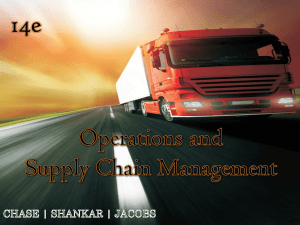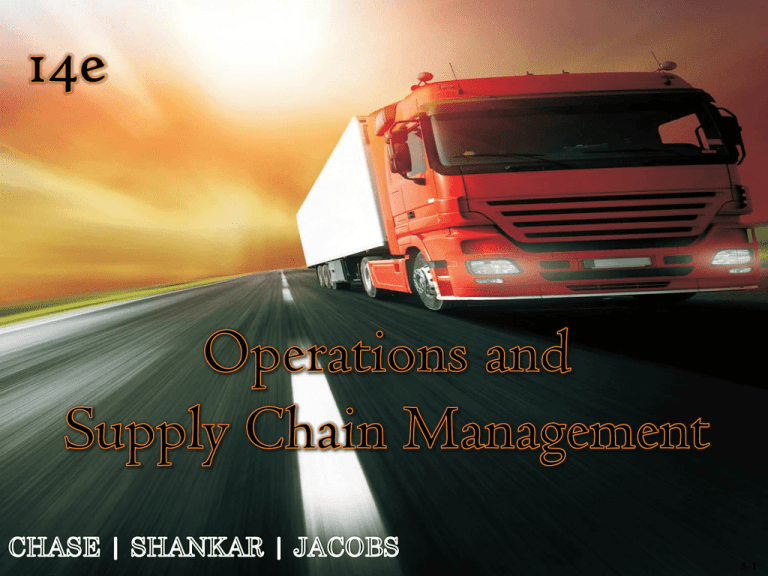
5–1
Chapter Five
McGraw-Hill/Irwin
Copyright © 2014 by The McGraw-Hill Companies, Inc. All rights reserved.
5–2
• LO5–2: Exemplify how to plan capacity.
• LO5–3: Evaluate capacity alternatives using
decision trees.
Copyright © 2014 by McGraw Hill Education (India) Private Limited. All rights reserved.
• LO5–1: Explain what capacity management is
and why it is strategically important.
• LO5–4: Compare capacity planning in services
to capacity planning in manufacturing
5–3
– Allows a T-shirt made in China to be sent to the
Netherlands for just 2.5 cents.
– The Eleonora Maersk and the other seven ships in her
class are among the largest ever built:
– Almost 400 m long, or the length of four soccer fields,
and another half-field across.
– The ships can carry 7,500 or so 40-foot containers, each
of which can hold 70,000 T-shirts.
Copyright © 2014 by McGraw Hill Education (India) Private Limited. All rights reserved.
• The Economics of Very Big Ships
• Economy of Container Ships
• On this voyage, the Eleonora was carrying supplies
for Europe’s New Year celebrations: 1,850 tons of
fireworks, including 30 tons of gunpowder.
5–4
• In business, viewed as the amount of
output that a system is capable of
achieving over a specific period of time
Copyright © 2014 by McGraw Hill Education (India) Private Limited. All rights reserved.
• Capacity – the ability to hold, receive,
store, or accommodate
• Capacity management needs to consider
both inputs and outputs
5–5
• Greater than one year
Intermediate range
• Monthly or quarterly plans covering the next 6 to
18 months
Copyright © 2014 by McGraw Hill Education (India) Private Limited. All rights reserved.
Long range
Short range
• Less than one month
5–6
– Facilities
– Equipment
– Labor force size
Copyright © 2014 by McGraw Hill Education (India) Private Limited. All rights reserved.
• Determining the overall level of
capacity-intensive resources that best
supports the company’s long-range
competitive strategy
5–7
• Economies of scale – the idea that as a planet
gets larger and volume increases, the average
cost per unit tends to drop
• Diseconomies of scale – at some point, the plant
becomes too large and average cost per unit
begins to increase
Copyright © 2014 by McGraw Hill Education (India) Private Limited. All rights reserved.
• Capacity utilization rate – a measure of how
close the firm is to its best possible operating
level
5–8
– Focused factory or plant within a plant (PWP)
concept
• Capacity flexibility – the ability to rapidly
increase or decrease product levels or the ability
to shift rapidly from one product or service to
another
Copyright © 2014 by McGraw Hill Education (India) Private Limited. All rights reserved.
• Capacity focus – the idea that a production
facility works best when it is concentrated on a
limited set of production objectives
– Comes from the plant, processes, and workers or
from strategies that use the capacity of other
organizations
5–9
• Ability to quickly adapt to change
• Zero-changeover time
Flexible
Processes
• Flexible manufacturing systems
• Simple, easily set up equipment
Flexible
Workers
• Ability to switch from one kind of
task to another quickly
• Multiple skills (cross training)
Copyright © 2014 by McGraw Hill Education (India) Private Limited. All rights reserved.
Flexible
Plants
5–10
•Similar capacities desired at each operation
•Manage bottleneck operations
Frequency of Capacity Additions
•Cost of upgrading too frequently
•Cost of upgrading too infrequently
External Sources of Capacity
•Outsourcing
•Sharing capacity
Copyright © 2014 by McGraw Hill Education (India) Private Limited. All rights reserved.
Maintaining System Balance
Decreasing Capacity
•Temporary reductions
•Permanent reductions
5–11
5–12
Copyright © 2014 by McGraw Hill Education (India) Private Limited. All rights reserved.
Calculate labor
and equipment
requirements to
meet forecasts
Project labor and
equipment
availability over
the planning
horizon
Copyright © 2014 by McGraw Hill Education (India) Private Limited. All rights reserved.
Use forecasting
to predict sales
for individual
products
5–13
– Paul’s and Newman’s
• Each is available in bottles and singleserving bags.
Copyright © 2014 by McGraw Hill Education (India) Private Limited. All rights reserved.
• Stewart Company produces two flavors
of salad dressing.
• What are the capacity and labor
requirements for the next five years?
5–14
Paul’s
Newman’s
Bottles (000s)
Plastic bags (000s)
Bottles (000s)
Plastic bags (000s)
Year
1
2
3
4
5
60
100
150
200
250
100
200
300
400
500
75
85
95
97
98
200
400
600
650
680
Copyright © 2014 by McGraw Hill Education (India) Private Limited. All rights reserved.
Step 1: Use forecasting to predict
sales for individual products
5–15
1
2
3
4
5
Bottles (000s)
135
185
245
297
348
Plastic bags (000s)
300
600
900
1050
1180
Bottling Operation
Year
Bagging Operation
Copyright © 2014 by McGraw Hill Education (India) Private Limited. All rights reserved.
Step 2: Calculate equipment
and labor requirements
5–16
1
2
3
4
5
Percentage capacity
utilized
24
48
72
84
94
Machine requirement
1.2
2.4
3.6
4.2
4.7
Labor requirement
3.6
7.2
10.8
12.6
14.1
Percentage capacity
utilized
30
41
54
66
77
Machine requirement
0.9
1.23
1.62
1.98
2.31
Labor requirement
1.8
2.46
3.24
3.96
4.62
Plastic Bag
Operation
Bottle
Operation
For the Excel template visit
www.mhhe.com/sie-chase14e
Excel: Capacity
Requirements
Copyright © 2014 by McGraw Hill Education (India) Private Limited. All rights reserved.
Year
Step 3: Project equipment
and labor availabilities
5–17
Copyright © 2014 by McGraw Hill Education (India) Private Limited. All rights reserved.
• A decision tree is a schematic model of the
sequence of steps in a problem – including the
conditions and consequences of each step.
• Decision trees help analysts understand the
problem and assist in identifying the best
solution.
• Decision tree components include the following:
– Decision nodes – represented with squares
– Chance nodes – represented with circles
– Paths – links between nodes
5–18
– Strong growth has a 55% probability
– New site cost is $210,000
Payoffs: strong growth = $195,000; weak growth =
$115,000
– Expanding current site cost is $87,000 (in either year 1 or 2)
Payoffs: strong growth = $190,000; weak growth =
$100,000
– Do nothing
Payoffs: strong growth = $170,000; weak growth =
$105,000
Copyright © 2014 by McGraw Hill Education (India) Private Limited. All rights reserved.
• The owner of Hackers Computer Store is evaluating
three options – expand at current site, expand to a new
site, do nothing.
• The decision process includes the following assumptions
and conditions.
5–19
Copyright © 2014 by McGraw Hill Education (India) Private Limited. All rights reserved.
• Calculate the value of each alternative
5–20
Events
Decision
Copyright © 2014 by McGraw Hill Education (India) Private Limited. All rights reserved.
• Diagram the problem chronologically
Decision
5–21
$765,000
$365,000
$863,000
$413,000
$843,000
Copyright © 2014 by McGraw Hill Education (India) Private Limited. All rights reserved.
• Calculate value of each branch
$850,000
$525,000
5–22
$765,000
$660,500
$365,000
Do nothing has higher
value than expand, so
$863,000
choose to
do nothing
$413,000
Do nothing = $703,750
Do nothing has higher
value than expand or
move, so choose to do
nothing
$703,750
Copyright © 2014 by McGraw Hill Education (India) Private Limited. All rights reserved.
• Work backwards to calculate the value of each
decision/event
$843,000
Do nothing = $850,000
$850,000
$525,000
5–23
Copyright © 2014 by McGraw Hill Education (India) Private Limited. All rights reserved.
• Decision tree analysis with net present value
calculations
Excel: Decision
Trees
For the Excel template visit
www.mhhe.com/sie-chase14e
5–24
Service
Capacity
Goods can be stored for later
use.
Capacity must be available
when service is needed –
cannot be stored.
Goods can be shipped to
other locations.
Service must be available at
customer demand point.
Volatility of demand is
relatively low.
Much higher volatility is
typical.
Copyright © 2014 by McGraw Hill Education (India) Private Limited. All rights reserved.
Manufacturing
Capacity
5–25
– Utilization is measured by the portion of time
servers are busy.
• Optimal levels of utilization are context specific.
– Low rates are appropriate when the degree of
uncertainty (in demand) is high and/or the stakes
are high (e.g., emergency rooms, fire departments).
– Higher rates are possible for predictable services or
those without extensive customer contact (e.g.,
commuter trains, postal sorting).
Copyright © 2014 by McGraw Hill Education (India) Private Limited. All rights reserved.
• The relationship between service capacity
utilization and service quality is critical.
5–26
Arrivals exceed
services – many
customers are never
served
declines – disruptions
or high arrival levels
lead to long wait times
Copyright © 2014 by McGraw Hill Education (India) Private Limited. All rights reserved.
• Rate of service utilization and service quality
are directly linked.
Service quality
Sufficient capacity to
provide quality
service
5–27

